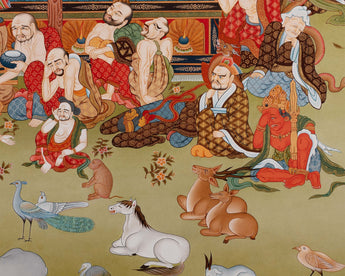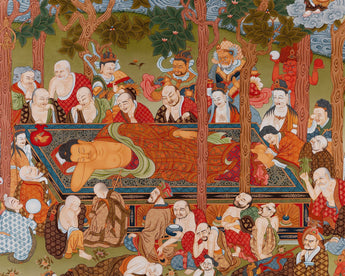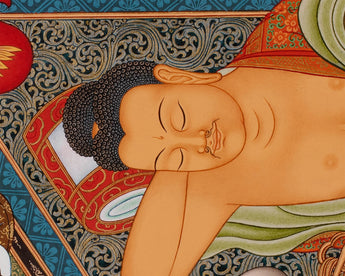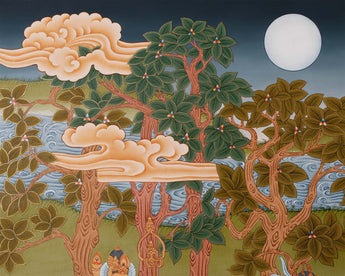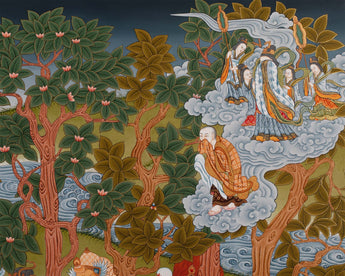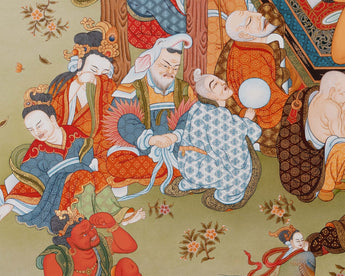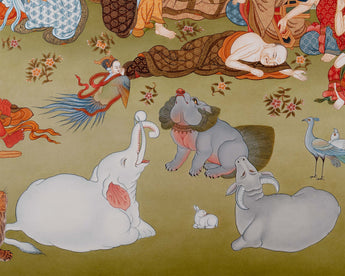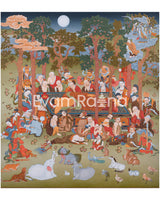
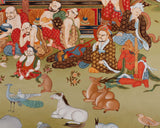
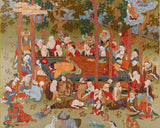
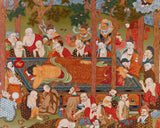
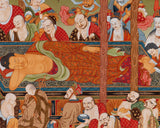

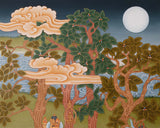
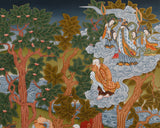
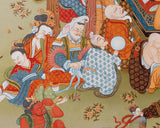
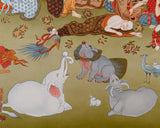
Buddha's Mahaparanirvana Thangka | Buddhist Handpainted Artwork | Wall Hanging Decor

100% AUTHENTIC

HANDPAINTED

FREE SHIPPING
Buddha's Mahaparanirvana Thangka
This image illustrates the passing of Shakyamuni Buddha( Parinirvana). A Buddha's Parinirvana is different from regular death because he already is liberated . Legend Has it that the earth Trembled, Celestial music filled the air, and there was a rain of heavenly flower petals.
He like every other sentient being passed away demonstrating the impermanence of life and the suffering of cyclic existence to his followers.
Background of Shakyamuni Buddha's Parinirvana
Shakyamuni's Parinirvana was a very rare occasion as it exemplified that any human can attain what Gautama Buddha had attained. His death in the middle of the jungle in Kushinagar, Uttar Pradesh also symbolizes impermanence. The enlightened one died a normal death just like any other human being,
Shakyamuni was around eighty-one years old when he attained parinirvana. Gautama Buddha was in a jungle of an ancient kingdom of Mallas at Kushinagar when he announced his near approaching parinirvana.
As per the granthas, he stopped in the village of Pava, where Chundra offered lunch to the Buddha. After eating the offered lunch, Buddha felt immediate discomfort and got very sick. However, Buddha told Ananda that Chundra's offerings were as holy as that of Sujata's offerings which taught Gautama Buddha the middle way.
His last sermon read: "All composite things are by nature impermanent. Work out your salvation with diligence".
He instructed his disciples to take dharma as their only teacher and not to rely on any person or anything else.
The legends say that the earth trembled, celestial music filled the air and flowers showered from the heavens.
Parinirvana Buddha Painting
This painting follows the Japanese style of Muromachi Period, 14th Century. This Japanese-style masterpiece includes subtle details, a few Japanese iconographies, and a beautiful illustration of Gautama Buddha's final departure from the realm of suffering.
The central figure in this painting illustrates Gautama Buddha lying on his right side, resting his head on his right palm putting one leg over the other in a lion's pose. His body is seen facing north, which intends to tell us that his teachings will spread to the north. -to Tibet, Mongolia and beyond.
Beside his pillow, we see a cuckoo bird in a cage ready to fly away. This iconography is often used by Japanese artists. The flight-ready Cuckoo in Japanese art is a symbol of entering the sects of the Buddhas or freedom from the samsara.
This painting is an exact illustration of Shakyamuni's parinirvana as per the Pali canonical "Mahaparinibbana Sutta"
Buddha, despite being in his final hour, is painted with sound and peaceful gestures as if he is resting. The arahantas around him are the only ones who are able to retain their composure in this great time of grief.
The environment of the Painting
The scene or environment looks a bit exaggerated. For example, the trees are bowing towards the buddha attending Parinirvana and the animals around are howling in grief with many humans and non-humans lay low absorbed by sadness.
Though the painting gives the feel of a daytime showing clear green hills and the beautiful scenery in the background, a full moon is placed above trees and the clouds.
Figures surrounding Shakyamuni
It is believed that when a realized being dies fulfilling his purpose, even devas from different realms come down to earth to witness this supreme site and pay respect .
In this thangka painting, we see over fifty humane icons that include various heavenly and demonic figures along with many animal figures attending Buddha's Parinirvana.
The angels on the top left of the painting are seen accompanying BUddha’s mother.
The artist has drawn several flowers scattered all around Buddha's bier. It is believed that the angels in heaven along with the trees showered Shakyamuni's body with flowers.
In the first row of Shakyamuni's bier, we see various Arahantas who are seen either looking at The Parinirvana Buddha or gazing at the sky. Among these arihants the around Buddha’s feet is Bhante Ananda - Shakyamuni's principal attendant and Cousin.
Likewise, there are various other Bhikkhus who are seen saddened but the one who's lying on the ground is Subhadra, Buddha's final convert. Some bhikkhus are also seen seated with facepalm gestures which symbolize disappointment over the untimely death of Shakyamuni.
Then we see 14 heavenly beings surrounding Shakyamuni. The male figure on the extreme left corner of this painting is Lord Indra, framed between two branches of the Saal tree. Indra, the lord of heaven (Deva Loka) is believed to be singing songs about Shakyamuni's accomplishments. Just beside Indra, we have a multi-headed demonic figure representing a Asura.
Around Shakyamuni, iconographies with crowns and jewels must be the kings and royals , and then non human looking figures must be Dharmapalas.
The whole painting is a graphical representation of SHakyamuni’s final moments before he was cremated.
In this last moments, The BUddha is seen among living Bhikkhus, Heavenly Beings, Kings and Royalties and various other sentient beings visible and non visible to the naked eye, who are all there to witness the final liberation of the ENLIGHTENED ONE
------------------------------------------------------------------
Size: 35"/ 89 cm (width) x 39"/ 100 cm (height)
Materials: Cotton Canvas, Acrylic Colors, Genuine 24K Gold
------------------------------------------------------------------
THIS THANGKA IS HAND-PAINTED IN THE TRADITIONAL STYLE AND THE QUALITY IS HIGH



